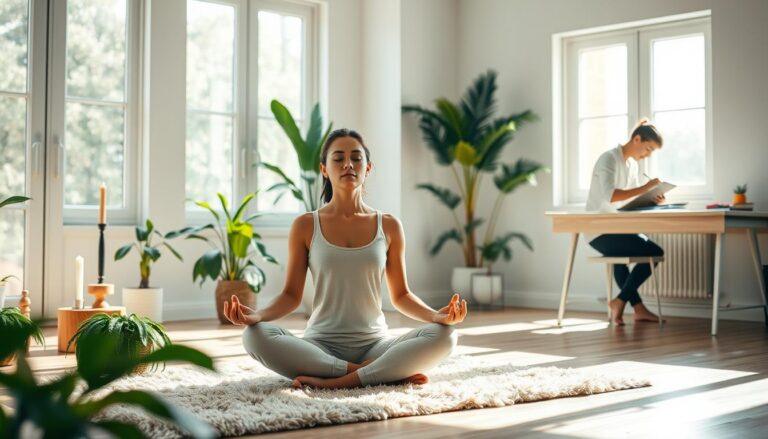Modern life often feels like balancing on a tightrope. Between work demands, personal responsibilities, and world events, maintaining mental equilibrium can seem impossible. But what if steady calmness wasn’t about escaping life’s storms – but learning to dance in the rain?
The secret lies in small, repeatable actions that fit your existing lifestyle. You don’t need marathon meditation sessions or extreme habit overhauls. Lasting peace grows through brief moments of intentionality woven into your day.
This approach works because it aligns with how humans form habits. Neuroscience shows that micro-changes create lasting neural pathways when repeated consistently. A 60-second breathing exercise while waiting for coffee matters more than perfect hour-long rituals you abandon after three days.
Key Takeaways
- Inner peace grows through consistent small actions, not drastic life changes
- Daily habits create neural pathways for lasting calm
- Wellness practices should adapt to your existing routine
- Mental resilience develops through repeatable moments of pause
- Stress management begins with manageable daily choices
Let’s explore how to transform fleeting calm into your natural state – one practical step at a time. These strategies work whether you’re managing work stress, family chaos, or global uncertainty. The goal isn’t perfection, but progress that compounds over weeks and months.
Embrace a Morning Routine for Inner Calm
Your first waking hour acts like a tuning fork for the day’s rhythm. Instead of grabbing your phone or rushing into tasks, this golden window lets you shape your mental landscape before external demands take over. Think of it as planting seeds of calm that blossom through your schedule.
Pay Yourself First: A Morning Investment
Imagine treating your body and mind like VIP clients. Drinking water immediately after waking kickstarts your metabolism and clears overnight toxins. Research shows this simple act boosts energy levels by 14% within 30 minutes.
Try pairing hydration with sunlight exposure. Even five minutes outdoors resets your circadian clock. This combo works like nature’s espresso shot – no caffeine needed.
Create a Mindful Ritual to Start Your Day
Your morning routine should feel personal, not prescriptive. A teacher might journal while sipping tea. A parent could play uplifting podcasts during school prep. One CEO swears by reciting affirmations while walking her dog.
Struggle with consistency? Start with a two-minute version on hectic days:
- 1 deep breath before getting out of bed
- 1 grateful thought while brushing teeth
- 1 stretch reaching toward the ceiling
These micro-moments build resilience against stress avalanches later.
10 simple practices to Boost Your Daily Wellness
Wellness isn’t about radical transformations – it’s the art of stacking tiny victories throughout your day. Like building a mosaic from colorful fragments, minor adjustments to your regular patterns can reshape your physical vitality and mental clarity over time.
Simple Habit Changes for Overall Health
Start with easy wins that create ripple effects. Swap sitting for standing during phone calls. Add leafy greens to one meal daily. Take three deep breaths before checking emails. These micro-changes bypass resistance because they feel achievable.
Try these evidence-backed adjustments:
- Drink water before caffeine each morning
- Walk 5 minutes after every 90 minutes of sitting
- Use stairs instead of elevators for single-floor trips
Integrate Wellness Into Your Daily Routine
Anchor new behaviors to existing rhythms. Do calf raises while brushing teeth. Practice gratitude during red lights. Stretch during TV ad breaks. This habit stacking method makes wellness feel automatic rather than added work.
Remember, consistency beats intensity. A 2023 NIH study found people who made two small health changes monthly improved biomarkers more sustainably than those attempting major overhauls. Your healthspan grows through these daily deposits in your well-being bank.
Move, Breathe, and Connect With Nature
Your body thrives when it interacts with natural elements. Combining gentle motion with fresh air creates a powerful reset button for your system. Even urban environments offer pockets of green space – a park bench, a tree-lined street, or a potted plant on your fire escape.
Experience the Benefits of Outdoor Movement
Daily activities don’t need gym equipment or perfect weather. Try “movement snacks” – bite-sized actions that add up:
- Walk during lunch breaks
- Stretch under a shady tree
- Cycle to nearby errands
Research reveals surprising advantages. A 2022 study found people who walked outdoors lowered cortisol levels 28% faster than treadmill users. Natural light also boosts vitamin D production, supporting heart health and mood regulation.
| Indoor Activity | Outdoor Alternative | Benefit Boost |
|---|---|---|
| Office yoga | Park stretching | +40% stress reduction |
| Treadmill running | Trail jogging | +33% enjoyment |
| Stairmaster | Hill climbing | +25% calorie burn |
No nearby woods? Try “micro-nature” moments. Open windows during work calls. Water plants while barefoot. These small connections still engage your senses and calm racing thoughts.
Cultivate Mindfulness Through Meditation and Reflection
Mental clarity often gets buried under daily demands. Building awareness through intentional pauses helps you respond to challenges instead of reacting. These mindful checkpoints act like speed bumps for your racing thoughts.
Set Regular Mindful Checkpoints During Your Day
Choose natural transition points to pause. Before meetings, after emails, or while waiting in line. Ask: “What does my mind need right now?” or “Where do I feel stress in my body?”
Honor the answers. Adjust your posture. Take two deep breaths. Research shows even 90-second pauses lower cortisol by 15% over eight weeks. These micro-resets protect your health during hectic days.
Easy Meditation Techniques for Emotional Balance
Try the 5-3-1 method during work breaks:
- 5 breaths focusing on chest movement
- 3 sounds you hear nearby
- 1 physical sensation (like feet on floor)
Another option: body scan meditation. Spend 30 seconds noticing tension from head to toes. A 2023 UCLA study found this reduces anxiety in 78% of participants after three weeks.
| Traditional Approach | Checkpoint Method | Time Saved |
|---|---|---|
| 30-minute sessions | 90-second pauses | 83% |
| Quiet room required | Any environment | – |
| Formal training | Immediate use | – |
Remember: Consistency matters more than duration. Three minutes daily builds stronger neural pathways than hour-long weekly sessions. Your emotional toolkit grows one breath at a time.
Nourish Your Body With a Balanced Diet
What fuels both your physical energy and mental clarity? The answer lies in your plate. Food acts as foundational support for your body and mind, creating ripple effects that extend far beyond mealtimes.
Building Nutritional Resilience Through Balanced Choices
Forget strict diets that leave you hangry. Sustainable healthy eating focuses on abundance, not deprivation. Aim to fill half your plate with colorful fruits and vegetables at most meals. Pair them with lean proteins like fish or beans, and complex carbs like quinoa or whole grains.
Processed snacks and sugary drinks create energy rollercoasters. Swapping them for nuts or fresh berries stabilizes blood sugar levels. A 2024 Johns Hopkins study found people who ate this way reported 42% fewer afternoon energy crashes.
| Processed Food | Whole Food Alternative | Key Benefit |
|---|---|---|
| White bread | 100% whole grain | +3g fiber per slice |
| Soda | Infused water | No added sugars |
| Candy bar | Dark chocolate almonds | Healthy fats + antioxidants |
Start with one manageable change. Add spinach to morning eggs. Choose brown rice instead of white. These tweaks build nutritional resilience over time. Your immune system strengthens, and your health becomes less vulnerable to daily stressors.
Remember: Food isn’t just fuel – it’s information for your cells. Every bite either supports or strains your healthy lifestyle. By choosing nutrient-rich options consistently, you create lasting vitality from the inside out.
Schedule Microbreaks and Active Recovery Moments
Your calendar holds secret weapons against burnout – brief pauses strategically placed between tasks. Treating these recovery moments as non-negotiable appointments transforms how you approach work and wellness. A 2024 Stanford study found employees who took regular 12-minute breaks improved focus by 37% compared to non-stop workers.
Strategies for Taking Effective Short Breaks
The Five Forces of Recovery offer versatile tools for any environment:
- Solitude: Close your eyes for 90 seconds
- Connection: Chat with a colleague about non-work topics
- Nature: Feel sunlight through a window
- Music: Listen to one uplifting song
- Gratitude: Text someone a quick thank-you
| Traditional Break | Active Recovery | Effectiveness |
|---|---|---|
| Scrolling phone | Desk stretches | +50% energy |
| Coffee refill | Staircase walk | +33% focus |
| Snack break | Deep breathing | 27% stress drop |
Many people feel guilty stepping away from desks. Yet research shows taking seven minutes hourly prevents decision fatigue. Try setting phone alerts with messages like “Hydrate & Reset” – these nudges support consistent practice without willpower.
Communicate the value of pauses to teams: “These activities help me serve you better.” Most managers approve when framed as productivity boosters. Remember – protecting recovery time isn’t selfish. It’s essential for sustained health and performance.
Establish a Supportive Bedtime Routine
Your evening habits set the stage for how well your body and mind recharge. Just as morning routines prime your day, intentional wind-down practices help transition from activity to restoration. This isn’t about rigid schedules – it’s creating signals that tell your system “time to power down.”
Disconnect From Screens and Embrace Relaxation
Digital devices trick your brain into daytime mode. The blue light suppresses melatonin production by up to 23%, per 2024 sleep studies. Try turning off screens 60 minutes before bed. Replace scrolling with:
- Paperback reading under soft lighting
- Gentle yoga poses on a cozy mat
- Conversations with household members
These activities lower heart rate and ease mental chatter. Your bedroom becomes a sanctuary rather than an extension of your inbox.
Calming Pre-Sleep Activities to Enhance Rest
Consistency matters more than complexity. A nurse might sip chamomile tea while reviewing tomorrow’s schedule. A student could practice gratitude journaling. Try these science-backed options:
- 5-minute body scan meditation
- Light stretching to release tension
- Writing tomorrow’s priority list
Research shows people maintaining regular sleep times fall asleep 40% faster. Pair this with cool room temperatures (60-67°F) for optimal quality rest. Your cells repair best during deep sleep cycles – making these habits foundational for a healthy lifestyle.
Strengthen Resilience With Daily Movement Practices
Movement acts as nature’s reset button for both body and mind. Consistent physical activity builds a resilience reservoir that helps you navigate challenges with steadier footing. Whether stretching during work calls or dancing while cooking dinner, small bursts of motion create compounding benefits.
Quick Exercises To Refresh Your Energy
Your movement routine doesn’t need gym equipment or perfect form. Try these research-backed ideas:
- Take three “lap breaks” around your home hourly
- Do wall push-ups while waiting for coffee
- Practice chair yoga during virtual meetings
Studies show 30 minutes of daily activity – split into chunks – improves heart health as effectively as continuous sessions. A brisk walk after meals boosts digestion. Stretching breaks enhance joint flexibility. These micro-workouts fit seamlessly into your day.
Strength training offers unique advantages. Lifting groceries or doing bodyweight squats builds muscle mass while reducing inflammation. One example: Older adults who did brief resistance exercises daily maintained 40% better balance during stress tests.
Remember – movement fuels both physical vitality and mental clarity. Each step, stretch, or lift deposits energy into your health bank. Over time, these investments create compound interest in your capacity for calm.


